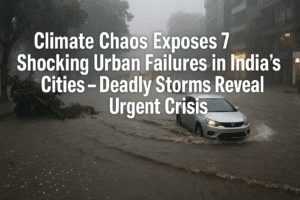Climate Chaos Exposes 7 Shocking Urban Failures in India’s Cities – Deadly Storms Reveal Urgent Crisis
Unseasonal torrential rains and hailstorms have unleashed chaos across India’s major cities, exposing critical urban vulnerabilities and amplifying climate-driven threats. Delhi’s violent hailstorm claimed four lives, injured dozens, and disrupted flights, while Mumbai’s pre-monsoon deluge flooded affluent neighborhoods, laying bare its crumbling drainage systems and waste management failures. Bengaluru, India’s tech hub, saw knee-deep water submerge streets and homes, killing four and paralyzing daily life.
These crises spotlight systemic neglect: overwhelmed infrastructure, poor disaster preparedness, and unchecked urbanization. Scientists link the erratic weather—including unseasonal storms and disrupted monsoons—to climate change, warning of intensifying extremes. Farmers face crop risks, while cities grapple with economic losses and safety threats. The recurring disasters underscore an urgent need for climate-resilient urban planning, upgraded drainage networks, and accountability in governance. Without swift reforms, India’s rapidly growing urban centers risk becoming unlivable for millions.

Climate Chaos Exposes 7 Shocking Urban Failures in India’s Cities – Deadly Storms Reveal Urgent Crisis
A series of violent storms and unrelenting rains have plunged major Indian cities into chaos this week, revealing stark vulnerabilities in urban infrastructure while underscoring the growing menace of climate-driven weather extremes. From lethal hailstorms in Delhi to submerged streets in Mumbai and Bengaluru, the crises have left millions grappling with disruption, danger, and systemic failures.
Delhi’s Hailstorm Horror: A Capital Under Siege
On Wednesday evening, Delhi faced nature’s fury as golf ball-sized hailstones pummeled the city, killing four people and injuring over a dozen. The storm uprooted trees, triggered power blackouts, and turned roads into rivers, stranding commuters for hours. At Indira Gandhi International Airport, 50 flights were delayed, with 11 diverted mid-air. A harrowing video from an Indigo flight to Srinagar captured passengers screaming as the plane shuddered through severe turbulence. Though the airline confirmed a safe landing, social media buzzed with images of the aircraft’s dented nose, sparking safety concerns.
The Delhi Metro issued warnings after debris clogged tracks, while hospitals reported a surge in hail-related injuries. “This wasn’t just rain—it felt like the sky was attacking us,” said Ramesh Kumar, a street vendor whose stall was destroyed.
Mumbai’s Pre-Monsoon Flooding: A Familiar Nightmare
Mumbai, India’s financial hub, faced its own reckoning as pre-monsoon showers inundated affluent areas like Andheri. Viral videos showed plastic waste swirling through flooded streets, exposing chronic drainage failures. Residents lambasted civic authorities for neglecting infrastructure despite annual deluges. “Every year, we see the same scenes. When will the city invest in solutions?” tweeted activist Anjali Patil.
Local businesses suffered heavy losses, with shop owners scrambling to salvage inventory. Meanwhile, the India Meteorological Department (IMD) issued alerts for “heavy to very heavy rainfall” along the western coast, urging coastal states to brace for more chaos.
Bengaluru’s Tech Hub Brought to Its Knees
Earlier in the week, Bengaluru—India’s Silicon Valley—ground to a halt as torrential rains flooded streets and homes. Four fatalities were reported, including a 45-year-old man trapped in a collapsed storm drain. Tech workers waded through knee-deep water, while luxury cars floated like driftwood. The city’s crumbling drainage system, compounded by unchecked urbanization, faced sharp criticism. “Bengaluru’s infrastructure can’t handle its growth,” said urban planner Vidhya Rao. “Climate resilience must become a priority.”
The Bigger Picture: Climate Change and Monsoon Uncertainty
While India’s monsoon, which delivers 80% of its annual rainfall, is vital for agriculture and livelihoods, climate change has disrupted its rhythm. Erratic rains, unseasonal storms, and extreme heat are now frequent, according to IMD scientists. Farmers, who rely on monsoon predictability, face crop losses and debt, while cities ill-equipped for such volatility see daily life upended.
“This isn’t an anomaly—it’s the new normal,” said climate scientist Dr. Anika Verma. “Rising global temperatures are intensifying weather patterns, and our cities are not prepared.”
A Call for Action: Bridging Gaps in Infrastructure and Policy
The recent disasters highlight urgent gaps in urban planning and disaster management. Mumbai’s clogged drains, Delhi’s fragile power grids, and Bengaluru’s illegal encroachments on lakes underscore systemic neglect. Experts argue for climate-resilient infrastructure, robust waste management, and updated drainage systems.
Citizen-led initiatives, such as Bengaluru’s lake restoration projects, offer hope, but systemic change requires political will. As storms grow fiercer, the stakes for India’s cities—and their 400 million urban residents—have never been higher.
The Takeaway
This week’s storms are a wake-up call: climate change is no longer a distant threat but a present crisis. For India, balancing rapid urbanization with ecological sustainability will determine whether its cities sink or survive. The time for ad-hoc fixes is over—transformative action is now a matter of life and death.
You must be logged in to post a comment.